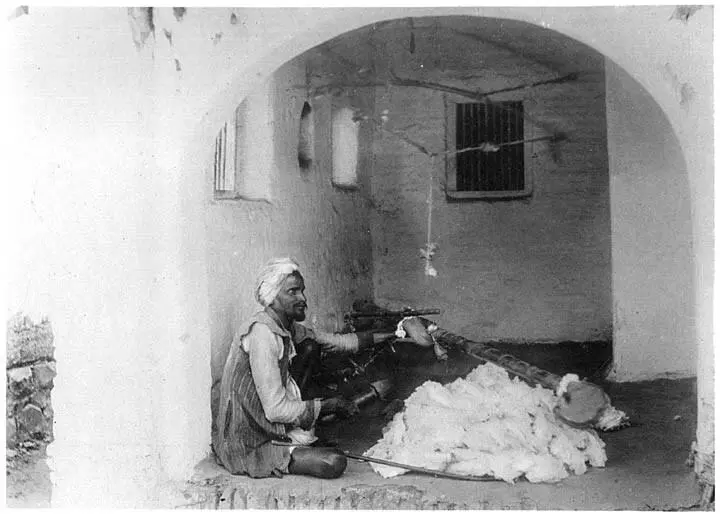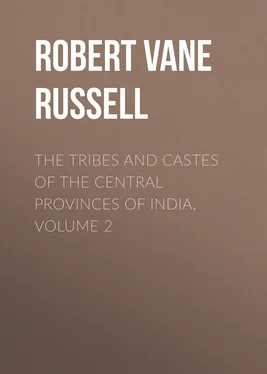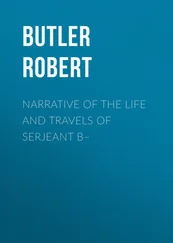Robert Vane Russell - The Tribes and Castes of the Central Provinces of India, Volume 2
Здесь есть возможность читать онлайн «Robert Vane Russell - The Tribes and Castes of the Central Provinces of India, Volume 2» — ознакомительный отрывок электронной книги совершенно бесплатно, а после прочтения отрывка купить полную версию. В некоторых случаях можно слушать аудио, скачать через торрент в формате fb2 и присутствует краткое содержание. Жанр: foreign_prose, История, foreign_edu, foreign_antique, на английском языке. Описание произведения, (предисловие) а так же отзывы посетителей доступны на портале библиотеки ЛибКат.
- Название:The Tribes and Castes of the Central Provinces of India, Volume 2
- Автор:
- Жанр:
- Год:неизвестен
- ISBN:нет данных
- Рейтинг книги:4 / 5. Голосов: 1
-
Избранное:Добавить в избранное
- Отзывы:
-
Ваша оценка:
- 80
- 1
- 2
- 3
- 4
- 5
The Tribes and Castes of the Central Provinces of India, Volume 2: краткое содержание, описание и аннотация
Предлагаем к чтению аннотацию, описание, краткое содержание или предисловие (зависит от того, что написал сам автор книги «The Tribes and Castes of the Central Provinces of India, Volume 2»). Если вы не нашли необходимую информацию о книге — напишите в комментариях, мы постараемся отыскать её.
The Tribes and Castes of the Central Provinces of India, Volume 2 — читать онлайн ознакомительный отрывок
Ниже представлен текст книги, разбитый по страницам. Система сохранения места последней прочитанной страницы, позволяет с удобством читать онлайн бесплатно книгу «The Tribes and Castes of the Central Provinces of India, Volume 2», без необходимости каждый раз заново искать на чём Вы остановились. Поставьте закладку, и сможете в любой момент перейти на страницу, на которой закончили чтение.
Интервал:
Закладка:

The addition of a number of vertical strokes inside the loop signifies the number of males in a gang. If these strokes are enclosed by a circle it means that the gang is encamped in the vicinity; while a square inside a circle and line as below means that property has been secured by friends who have left in the direction pointed by the line. It is said that Baorias will follow one another up for fifty or even a hundred miles by means of these hieroglyphics. The signs are bold marks, sometimes even a foot or more in length, and are made where they will at once catch the eye. When the Mārwāri Baorias desire to indicate to others of their caste, who may follow in their footsteps, the route taken, a member of the gang, usually a woman, trails a stick in the dust as she walks along, leaving a spiral track on the ground. Another method of indicating the route taken is to place leaves under stones at intervals along the road. 77 77 Kennedy, loc. cit. p. 208.
The form of crime most in favour among the ordinary Baoris is housebreaking by night. Their common practice is to make a hole in the wall beside the door through which the hand passes to raise the latch; and only occasionally they dig a hole in the base of the wall to admit of the passage of a man, while another favoured alternative is to break in through a barred window, the bars being quickly and forcibly bent and drawn out. 78 78 Kennedy, loc. cit. p. 185.
One class of Mārwāri Bāgris are also expert coiners.

Bahna
1. Nomenclature and internal structure.
Bahna, Pinjāra, Dhunia. 79 79 This article is partly based on a paper by Munshi Kanhya Lāl of the Gazetteer office.
—The occupational caste of cotton-cleaners. The Bahnas numbered 48,000 persons in the Central Provinces and Berār in 1911. The large increase in the number of ginning-factories has ruined the Bahna’s trade of cleaning hand-ginned cotton, and as no distinction attaches to the name of Bahna it is possible that members of the caste who have taken to other occupations may have abandoned it and returned themselves simply as Muhammadans. The three names Bahna, Pinjāra, Dhunia appear to be used indifferently for the caste in this Province, though in other parts of India they are distinguished. Pinjāra is derived from the word pinjan used for a cotton-bow, and Dhunia is from dhunna , to card cotton. The caste is also known as Dhunak Pathāni. Though professing the Muhammadan religion, they still have many Hindu customs and ceremonies, and in the matter of inheritance our courts have held that they are subject to Hindu and not Muhammadan law. 80 80 Sir B. Robertson’s C.P. Census Report (1891), p. 203.
In Raipur a girl receives half the share of a boy in the division of inherited property. The caste appears to be a mixed occupational group, and is split into many territorial subcastes named after the different parts of the country from which its members have come, as Badharia from Badhas in Mīrzāpur, Sarsūtia from the Sāraswati river, Berāri of Berār, Dakhni from the Deccan, Telangi from Madras, Pardeshi from northern India, and so on. Two groups are occupational, the Newāris of Saugor, who make the thick newār tape used for the webbing of beds, and the Kanderas, who make fireworks and generally constitute a separate caste. There is considerable ground for supposing that the Bahnas are mainly derived from the caste of Telis or oil-pressers. In the Punjab Sir D. Ibbetson says 81 81 Punjab Census Report (1881), paras. 646, 647.
that the Penja or cotton-scutcher is an occupational name applied to Telis who follow this profession; and that the Penja, Kasai and Teli are all of the same caste. Similarly in Nāsik the Telis and Pinjāras are said to form one community, under the government of a single panchāyat . In cases of dispute or misconduct the usual penalty is temporary excommunication, which is known as the stopping of food and water. 82 82 Nāsik Gazetteer , pp. 84, 85.
The Telis are an enterprising community of very low status, and would therefore be naturally inclined to take to other occupations; many of them are shopkeepers, cultivators and landholders, and it is quite probable that in past times they took up the Bahna’s profession and changed their religion with the hope of improving their social status. The Telis are generally considered to be quarrelsome and talkative, and the Bahnas or Dhunias have the same characteristics. If one man abusing another lapses into Billingsgate, the other will say to him, ‘ Hamko Julāha Dhunia neh jāno ,’ or ‘Don’t talk to me as if I was a Julāha or a Dhunia.’
2. Marriage.
Some Bahnas have exogamous sections with Hindu names, while others are without these, and simply regulate their marriages by rules of relationship. They have the primitive Hindu custom of allowing a sister’s son to marry a brother’s daughter, but not vice versa . A man cannot marry his wife’s younger sister during her lifetime, nor her elder sister at any time. Children of the same foster-mother are also not allowed to marry. Their marriages are performed by a Kāzi with an imitation of the Nikāh rite. The bridegroom’s party sit under the marriage-shed, and the bride with the women of her party inside the house. The Kāzi selects two men, one from the bride’s party, who is known as the Nikāhi Bāp or ‘Marriage Father,’ and the other from the bridegroom’s, who is called the Gowāh or ‘Witness.’ These two men go to the bride and ask her whether she accepts the bridegroom, whose name is stated, for her husband. She answers in the affirmative, and mentions the amount of the dowry which she is to receive. The bridegroom, who has hitherto had a veil ( mukhna ) over his face, now takes it off, and the men go to him and ask him whether he accepts the bride. He replies that he does, and agrees to pay the dowry demanded by her. The Kāzi reads some texts and the guests are given a meal of rice and sugar. Many of the preliminaries to a Hindu marriage are performed by the more backward members of the caste, and until recently they erected a sacred post in the marriage-shed, but now they merely hang the green branch of a mango tree to the roof. The minimum amount of the mehar or dowry is said to be Rs. 125, but it is paid to the girl’s parents as a bride-price and not to herself, as among the Muhammadans. A widow is expected, but not obliged, to marry her deceased husband’s younger brother. Divorce is permitted by means of a written deed known as ‘Fārkhati.’

Pinjāra cleaning cotton.
3. Religious and other customs.
The Bahnas venerate Muhammad, and also worship the tombs of Muhammadan saints or Pīrs . A green sheet or cloth is spread over the tomb and a lamp is kept burning by it, while offerings of incense and flowers are made. When the new cotton crop has been gathered they lay some new cotton by their bow and mallet and make an offering of malīda or cakes of flour and sugar to it. They believe that two angels, one good and one bad, are perched continually on the shoulders of every man to record his good and evil deeds. And when an eclipse occurs they say that the sun and moon have gone behind a pinnacle or tower of the heavens. For exorcising evil spirits they write texts of the Korān on paper and burn them before the sufferer. The caste bury the dead with the feet pointing to the south. On the way to the grave each one of the mourners places his shoulder under the bier for a time, partaking of the impurity communicated by it. Incense is burnt daily in the name of a deceased person for forty days after his death, with the object probably of preventing his ghost from returning to haunt the house. Muhammadan beggars are fed on the tenth day. Similarly, after the birth of a child a woman is unclean for forty days, and cannot cook for her husband during that period. A child’s hair is cut for the first time on the tenth or twelfth day after birth, this being known as Jhālar. Some parents leave a lock of hair to grow on the head in the name of the famous saint Sheikh Farīd, thinking that they will thus ensure a long life for the child. It is probably in reality a way of preserving the Hindu choti or scalp-lock.
Читать дальшеИнтервал:
Закладка:
Похожие книги на «The Tribes and Castes of the Central Provinces of India, Volume 2»
Представляем Вашему вниманию похожие книги на «The Tribes and Castes of the Central Provinces of India, Volume 2» списком для выбора. Мы отобрали схожую по названию и смыслу литературу в надежде предоставить читателям больше вариантов отыскать новые, интересные, ещё непрочитанные произведения.
Обсуждение, отзывы о книге «The Tribes and Castes of the Central Provinces of India, Volume 2» и просто собственные мнения читателей. Оставьте ваши комментарии, напишите, что Вы думаете о произведении, его смысле или главных героях. Укажите что конкретно понравилось, а что нет, и почему Вы так считаете.












